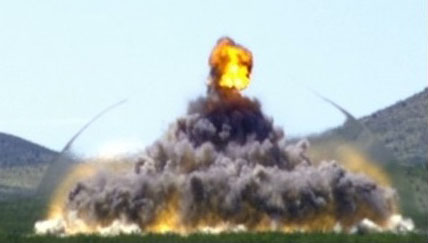In physics, a shock wave (also spelled shockwave), or shock, is a type of propagating disturbance. When a wave moves faster than the local speed of sound in a fluid, it is a shock wave. Like an ordinary wave, a shock wave carries energy and can propagate through a medium; however, it is characterized by an abrupt, nearly discontinuous change in pressure, temperature and density of the medium. In supersonic flows, expansion is achieved through an expansion fan, also known as a Prandtl-Meyer expansion fan. Wikipedia, Shock Wave


If you stood near a giant rocket as it took off, the sound alone would blow out your eardrums, shatter your bones and rupture internal organs. The threshold of pain is about 130 dB. More than 160 decibels at close range is probably not survivable. In human terms we can’t experience, up close, sounds as loud as the biggest our technology can produce because they’d instantly kill us. But there’s also a physical limit to loudness. The loudness of sound in air is dictated by how large the amplitude of sound waves is compared to the ambient air pressure. At 194 dB, a sound wave has a pressure deviation equal to the normal atmospheric pressure at sea-level. Essentially, at this intensity the sound waves create a complete vacuum between themselves so that any further increase would mean the sound gets ‘clipped’. Anything above 194 dB isn’t sound in the conventional sense of a series of compressions and rarefactions. The energy of the source starts to distort the entire wave, producing not bigger and bigger peaks and troughs of pressure but a shock wave. Instead of sounds passing through the air, the result is a series of pressurized bursts. This is one of the main reasons that large rockets produce a crackling noise rather than a steady roar. [anon]
See Also
Compression Wave
Compression Wave Velocity
Figure 8.1 - Russells Painting of Wave Form Dynamics
Figure 8.14 - Some Basic Waveforms and their constituent Aliquot Parts
Figure 8.2 - Compression Wave Phase Illustration
Figure 8.3 - Coiled Spring showing Longitudinal Wave
Figure 8.4 - Transverse Wave
Figure 9.11 - Compression Wave with expanded and contracted Orbits
Figure 9.9 - Wave Disturbance from 0 Center to 0 Center
In the Wave lies the Secret of Creation
Longitudinal Wave
Nodal Waves
Pseudo Velocity Shock Spectrum
Standing Wave
Standing Waves
Table 12.02.01 - Wavelengths and Frequencies
Three Main Parts of a Wave
Transverse Wave
wave
Velocity of Sound
3.9 - Nodes Travel Faster Than Waves or Light
8.3 - Conventional View of Wave Motion
8.4 - Wave types and metaphors
8.5 - Wave Motion Observables
8.6 - Wave Form Components
9.2 - Wave Velocity Propagation Questions
9.30 - Eighteen Attributes of a Wave
9.34 - Wave Propagation
9.35 - Wave Flow
12.05 - Three Main Parts of a Wave
